Tofana
Itineraries
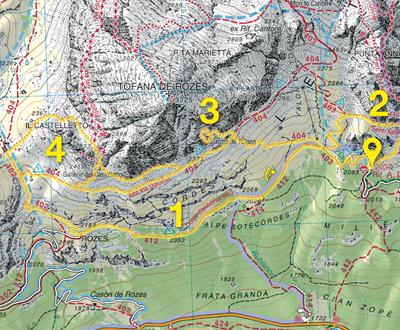
Alpe di Sotecórdes
Alpe di Sotecórdes
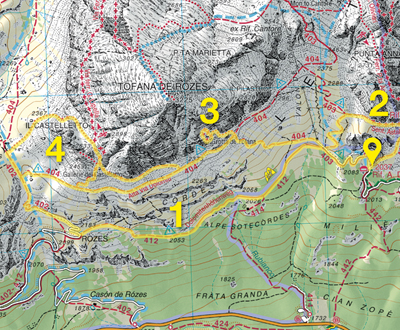
The southern base of Tofana di Ròzes is marked by two characteristic, horizontal and parallel rock layers: the so called Còrdes; a spectacular trail runs all along beneath their base. With their shelters below the overhanging rocks, the Còrdes alternate with steep meadows and are very warm and protected, suitable wintering areas for the local fauna and niches hosting rare flora and fauna species.
Length: 6.800 m.Vertical gain: 400 m.
Time required: 3 ore
×
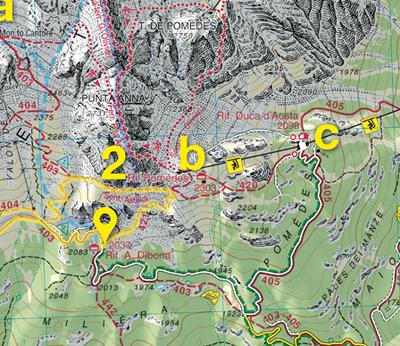
the Róš - Astaldi Trail
the Róš - Astaldi Trail
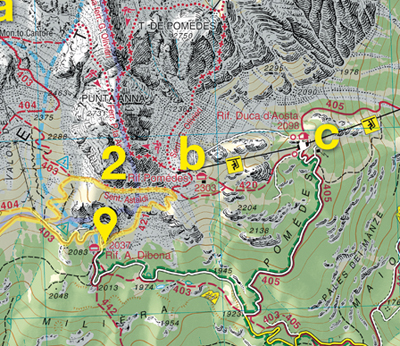
The base of the imposing walls of Principal Dolomia in the Tofane group is made of the fragile red and gray clays of the Travenanzes Formation. The Astaldi trail, equipped with iron cable for support, skirts along a highly spectacular section just above Rifugio Dibona. The erodibility of the clays at the wall “foot” sometimes leaves the above rock faces without support, thus causing ruinous collapse that feeds the screes below.
Length: 2.900 m.Vertical gain: 200 m.
Time required: 2 ore
×
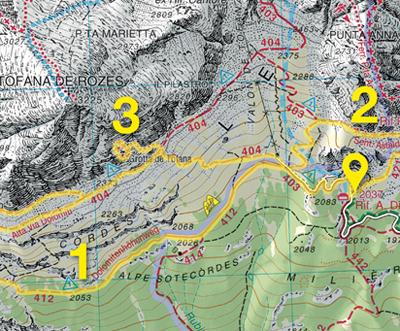
Tofana Cave
Tofana Cave
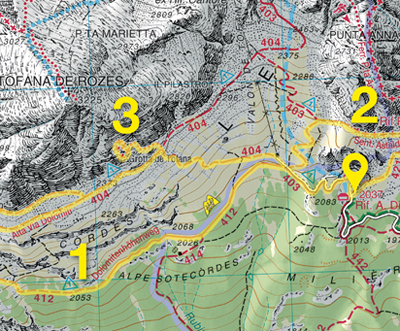
In the basal Dolomia of Tofana di Ròzes there is a large, ancient Karstic tunnel; this atypical cave can be visited through a short trail equipped for support. The Tofana Cave has a helicoidal development, it is about 150 m long and its vault can be as high as 10 m. In spring the top of the vault might happen to be oozing while the temperature at the base is below zero and incredible ice stalagmites may form: a spectacular phenomenon, unique in its kind.
Length: 2.000 m.Vertical gain: 400 m.
Time required: 3 ore
×
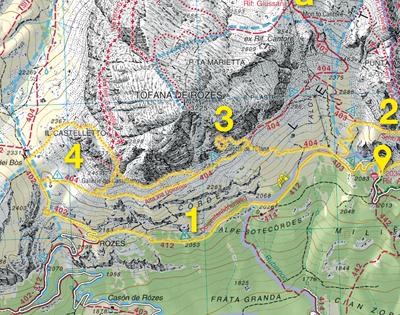
Col dei Bós - Castelletto
Col dei Bós - Castelletto
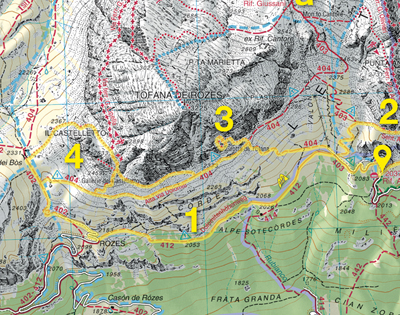
Forcella Col dei Bòs area was a nerve-centre for the events of World War 1. Among the most significant remains, over and above fortified boulders and trenches, is the mine tunnel of the Castelletto which is equipped for support and can be visited. The summit of Col dei Bos and the Travenanzes sources are both of great historical interest and among the most valuable and vulnerable zones in the Ampezzo Dolomites for their high altitude fauna and flora.
Length: 4.200 m.Vertical gain: 500 m.
Time required: 4 ore
×
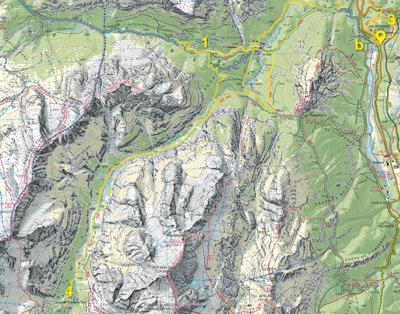
Val Travenànzes
Val Travenànzes
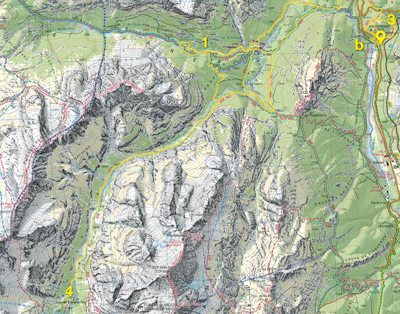
This is the wildest valley of the Park, without roads or huts; the primordial beauty of this glacial valley with flat bottom and harsh, vertical slopes is extraordinary. The grassland and bogs of the upper part disappear in its lower part swallowed by mugo pines and debris flow. Val Travenànzes becomes deeper and narrower towards its confluence with Val di Fanes. Good weather conditions and a minimum training are required to hike this fascinating destination.
Length: 8.000 m.Vertical gain: 660 m.
Time required: 6 ore
×
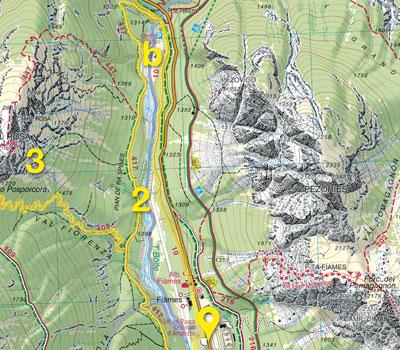
Pian de ra Špines
Pian de ra Špines
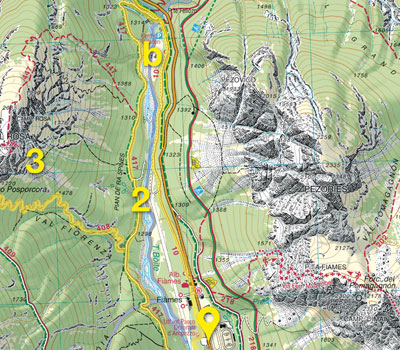
The alluvial plain formed by the Boite north of Cortina is a natural area where the landscape changes and renovates at each flood and course diversion of the river. In this stretch, waters are clear and free to run on a wide bed of rock debris. The trail that circumnavigates Pian de ra Špines, is suitable for many sports activities and accessible to disabled.
Length: 8.000 m.Vertical gain: 100 m.
Time required: 2 ore
×
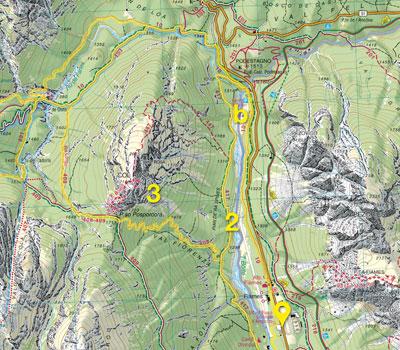
Loop of Col Rosà
Loop of Col Rosà
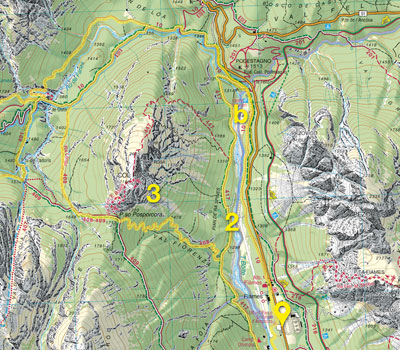
On the eastern slopes of Col Rosà, towards the Boite, beech trees ascend the slopes encouraged by the sirocco current rising from the valley floor and form a strip of pristine beech forest. On the opposite side, where low temperatures of the gorge climate prevail, stone pines are found at low altitudes. Easy trails lead around the entire mountain to appreciate the different eco-systems and the geomorphological peculiarities of Campanile Rosà and the gorge of Ru de ra Vales.
Length: 12.500 m.Vertical gain: 430 m.
Time required: 3,5 ore
×
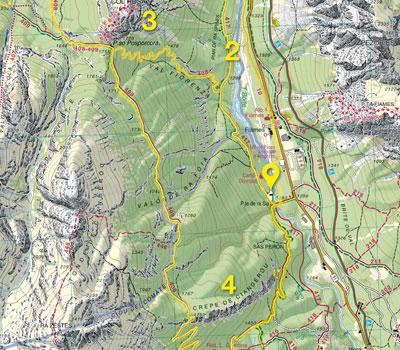
Cianderòu - Pospórcora
Cianderòu - Pospórcora
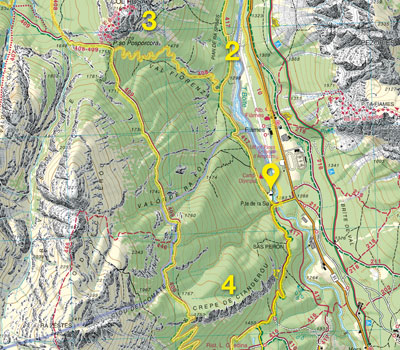
The rocky hill of Cianderou, which can be easily accessed from Lago Ghedina, is an excellent viewpoint over the Ampezzo valley. The winding road ascends through a spectacular larch forest, where woodpeckers can often be heard. The equally panoramic altitude traverse route to Passo Posporcora and the subsequent descent into Val Fiorenza, which utilizes wartime trails, passes through an area of considerable wildlife value.
Length: 10.000 m.Vertical gain: 500 m.
Time required: 4 ore
×
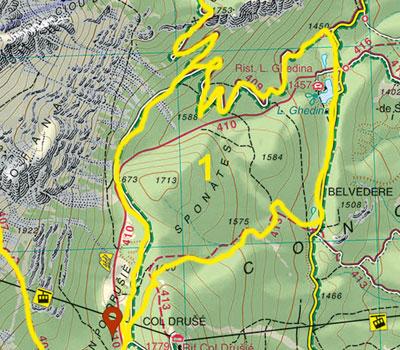
Lago Ghedina - In Pó Drušié
Lago Ghedina - In Pó Drušié
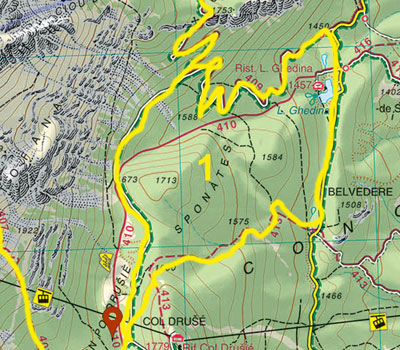
The hill of ra Sponàtes, next to Col Drušié, is covered with a thin coniferous forest, showing little of man's intervention and inhabited by several species of galliformes. The hill can be travelled around its base, walking by Lago Ghedina and along a winding, convenient military road. The lake is a wonderful water expanse that fills a basin at the back of one of the hills that originated with the post glacial landslides of Tofana.
Length: 5.200 m.Vertical gain: 220 m.
Time required: 2,5 ore
×
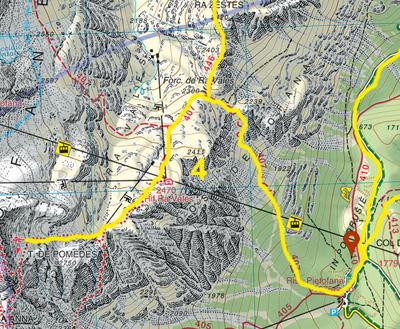
Torrioni di Pomédes
Torrioni di Pomédes
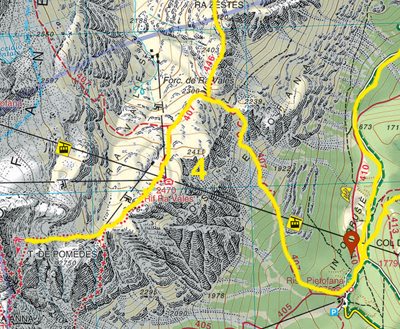
The eastern slope of Tofana has a rather complex morphology due to the action of tectonic and glacial forces that shaped it. The wide Ra Vales basin rests entirely on banks of Principal Dolomia; to the north it sinks into a deep gorge, while to the south it ends sheer above Cortina's bowl with some spectacular reliefs. The most panoramic is Terzo Torrione di Pomedes, rich in endemic flowers, which can easily be reached from Ra Vales.
Length: 4.500 m.Vertical gain: 1.200 m.
Time required: 3 ore
×
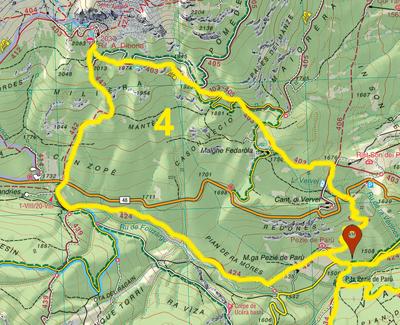
Mantel - Rifugio Dibona
Mantel - Rifugio Dibona
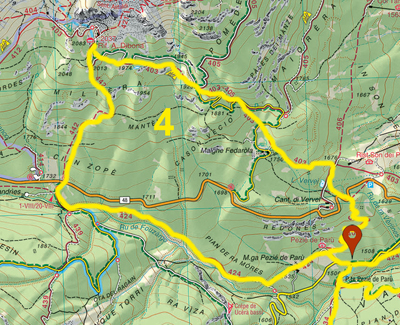
The route ascending the southern slopes of Tofana mainly follows easy wartime trails and intersects ski runs, though it is not much disturbed by them. The woods of its higher belt, at the upper limit of the vegetation or on the Mantel slopes have a noble bearing, are rich in biomass and consequently rich in wildlife biodiversity. Resting on the Triassic marls and clays of the San Cassiano formation, the whole mountainside is subject to landslides and, at the same time, rich in fossil outcrop.
Length: 12.800 m.Vertical gain: 800 m.
Time required: 5 ore
×